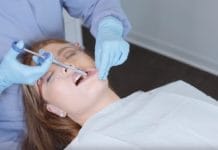Poor maternal oral health has been associated with adverse pregnancy and birth outcomes and early childhood caries. An estimated 75% of pregnant people develop gingivitis, with only about 40% of pregnant people receiving dental hygiene care during pregnancy. Additionally, those from socio-economically disadvantaged groups have high rates of untreated dental caries.1
Though interprofessional guidelines for oral health care during pregnancy were published in 2012, there are still apparent gaps in guideline awareness among providers. A study examined prenatal and oral health providers’ “awareness, familiarity, beliefs, self-efficacy, and practice behaviors related to interprofessional prenatal oral health guidelines.”1
The Study
The study sample included prenatal providers and dental providers in Florida. Participants were chosen through randomization and convenience sampling. Prenatal providers included medical doctors (MD), doctors of osteopathic medicine (DO), and certified nurse midwives (CNM). Dental professionals included doctors of dental surgery (DDS) and doctors of medicine in dentistry (DMD). All participants were licensed in the state of Florida.1
The participants took a survey. The survey began with measuring awareness and familiarity with the current guidelines. Response options included yes, no, and not sure.1
Additional questions assessed beliefs about oral health during pregnancy, including oral health and overall health, oral health care during pregnancy, and oral health hygiene behaviors. Practice behaviors and self-efficacy included questions assessing participants’ confidence in checking pregnant patients’ mouths for problems and overall behaviors of advising, referring, sharing, and coordinating care. Responses for these questions were a five-point Likert scale range with (1) being never and (5) always, with variations between.1
A total of 275 providers completed the survey, with 134 being prenatal providers and 141 dental providers.1
The Results
Fifty-seven percent of prenatal providers and 65% of dental providers were aware of the guidelines. Statistical differences between provider types were identified in the area of familiarity. Dental provider’s familiarity was significantly higher than that of prenatal providers.1
On average, both provider types strongly agreed with all belief items. Prenatal providers strongly agreed with the statement, “Seeking oral health care is safe during pregnancy.” Dental providers reported the strongest agreement with the statement, “Oral health is important for the overall health of my pregnant patients.”1
Prenatal providers reported the lowest agreement with the statement, “Mothers can transmit the bacteria that causes cavities to their infants by kissing or sharing spoons.” Dental providers reported the lowest agreement with the statement, “My professional organization has guidance on oral health promotion and care during pregnancy.”1
Regarding confidence, prenatal providers were most confident in advising pregnant patients to eat healthy foods. However, they were least confident checking their patient’s mouths for any disease indications.1
Dental providers reported being most confident advising pregnant patients on good oral hygiene. They reported the least confidence in sharing information about pregnant patients with prenatal providers.1
Interestingly, the more years in practice, the less agreement there is with the statement “seeking oral health care is safe during pregnancy” among dental providers. Conversely, prenatal providers who were in practice longer were more aware of guidelines than those with fewer reported years in practice.1
This finding suggests that there is a need for different education strategies to ensure providers are adequately informed of current guidelines. Strategies include improving education on this topic for emerging prenatal providers and improving continuing education opportunities for dental providers who have been practicing for several years.1
In Conclusion
This study revealed significant gaps in prenatal and oral health providers’ knowledge, familiarity, attitudes, and practices concerning interprofessional prenatal oral health guidelines. While provider education is a vital strategy for implementing these guidelines, broader organizational and policy-level changes may also be necessary to support effective practices during clinical care.1
Future research should highlight professional organizations’ critical role in connecting providers with up-to-date policies, guidelines, best practices, and other resources. This is especially important in fostering interprofessional collaboration in patient care.1
Before you leave, check out the Today’s RDH self-study CE courses. All courses are peer-reviewed and non-sponsored to focus solely on high-quality education. Click here now.
Listen to the Today’s RDH Dental Hygiene Podcast Below:
Reference
1. Vamos, C.A., Cayama, M.R., Mahony, H. et al. Oral Health during Pregnancy: An Analysis of Interprofessional Guideline Awareness and Practice Behaviors among Prenatal and Oral Health Providers. BMC Pregnancy and Childbirth. 2023; 23(1): 721. https://pmc.ncbi.nlm.nih.gov/articles/PMC10566079/











